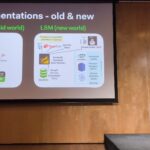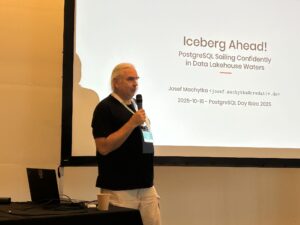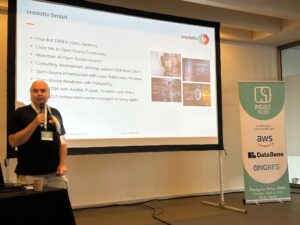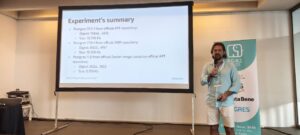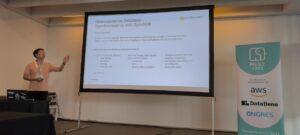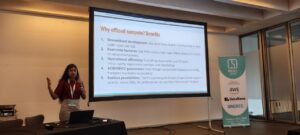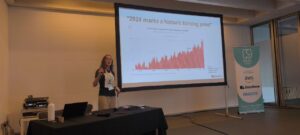The European PostgreSQL Conference (PGConf.EU) is one of the largest PostgreSQL events worldwide. In this year it was held 21–24 October in Riga, Latvia. Our company, credativ GmbH, was a bronze sponsor of the conference, and I had the privilege to represent credativ with my talk “Database in Distress: Testing and Repairing Different Types of Database Corruption.” In addition, I volunteered as a session host on Thursday and Friday. The conference itself covered a wide range of PostgreSQL topics – from cloud-native deployments to AI integration, from large-scale migrations to resiliency. Below are highlights from sessions I attended, organised by day.
My talk about database corruption
I presenting my talk on Friday afternoon. In it I dove into real-world cases of PostgreSQL database corruption I encountered over the past two years. To investigate these issues, I built a Python tool that deliberately corrupts database pages and then examined the results using PostgreSQL’s pageinspect extension. During the talk I demonstrated various corruption scenarios and the errors they produce, explaining how to diagnose each case. A key point was that PostgreSQL 18 now enables data checksums by default at initdb. Checksums allow damaged pages to be detected and safely “zeroed out” (skipping corrupted data) during recovery. Without checksums, only pages with clearly corrupted headers can be automatically removed using the zero_damaged_pages = on setting. Other types of corruption require careful manual salvage. I concluded by suggesting improvements (in code or settings) to make recovery easier on clusters without checksums.
Tuesday: Kubernetes and AI Summits
Tuesday began with two half-day Summits. The PostgreSQL on Kubernetes Summit explored running Postgres in cloud-native environments. Speakers compared Kubernetes operators (CloudNativePG, Crunchy, Zalando, etc.), backup/recovery in Kubernetes, scaling strategies, monitoring, and zero-downtime upgrades. They discussed operator architectures and multi-tenant DBaaS use cases. Attendees gained practical insight into trade-offs of different operators and how to run Kubernetes-based Postgres for high availability.
In the PostgreSQL & AI Summit, experts examined Postgres’s role in AI applications. Topics included vector search (e.g. pgvector), hybrid search, using Postgres as context storage for AI agents, conversational query interfaces, and even tuning Postgres with machine learning. Presenters shared best practices and integration strategies for building AI-driven solutions with Postgres. In short, the summit explored how PostgreSQL can serve AI workloads (and vice versa) and what new features or extensions are emerging for AI use cases.
Wednesday: Migrations, Modelling, and Performance
Joaquim Oliveira (European Space Agency) discussed moving astronomy datasets (from ESA’s Gaia and Euclid missions) off Greenplum. The team considered both scaling out with Citus and moving to EDB’s new Greenplum-based cloud warehouse. He covered the practical pros and cons of each path and the operational changes required to re-architect such exascale workloads. The key lesson was planning architecture, tooling, and admin shifts needed before undertaking a petabyte-scale migration.
Boriss Mejias (EDB) emphasised that data modelling is fundamental to software projects. Using a chess-tournament application as an example, he showed how to let PostgreSQL enforce data integrity. By carefully choosing data types and constraints, developers can embed much of the business logic directly in the schema. The talk demonstrated “letting PostgreSQL guarantee data integrity” and building application logic at the database layer.
Roberto Mello (Snowflake) reviewed the many optimizer and execution improvements in Postgres 18. For example, the planner now automatically eliminates unnecessary self-joins, converts IN (VALUES…) clauses into more efficient forms, and transforms OR clauses into arrays for faster index scans. It also speeds up set operations (INTERSECT, EXCEPT), window aggregates, and optimises SELECT DISTINCT and GROUP BY by reordering keys and ignoring redundant columns. Roberto compared query benchmarks across Postgres 16, 17, and 18 to highlight these gains.
Nelson Calero (Pythian) shared a “practical guide” for migrating 100+ PostgreSQL databases (from gigabytes to multi-terabytes) to the cloud. His team moved hundreds of on-prem VM databases to Google Cloud SQL. He discussed planning, downtime minimisation, instance sizing, tools, and post-migration tuning. In particular, he noted challenges like handling old version upgrades, inheritance schemas, PostGIS data, and service-account changes. Calero’s advice included choosing the right cloud instance types, optimising bulk data loads, and validating performance after migration.
Jan Wieremjewicz (Percona) recounted implementing Transparent Data Encryption (TDE) for Postgres via the pg_tde extension. He took the audience through the entire journey – from the initial idea, through patch proposals, to community feedback and design trade-offs. He explained why existing PostgreSQL hooks weren’t enough, what friction was encountered, and how customer feedback shaped the final design. This talk served as a “diary” of what it takes to deliver a core encryption feature through the PostgreSQL development process.
Stefan Fercot (Data Egret) demonstrated how to use Patroni (for high availability) together with pgBackRest (for backups). He walked through YAML configuration examples showing how to integrate pgBackRest into a Patroni-managed cluster. Stefan showed how to rebuild standby replicas from pgBackRest backups and perform point-in-time recovery (PITR) under Patroni’s control. The talk highlighted real-world operational wisdom: combining these tools provides automated, repeatable disaster recovery for Postgres clusters.
Thursday: Cloud, EXPLAIN, and Resiliency
Maximilian Stefanac and Philipp Thun (SAP SE) explained how SAP uses PostgreSQL within Cloud Foundry (SAP’s open-source PaaS). They discussed optimisations and scale challenges of running Postgres for SAP’s Business Technology Platform. Over the years, SAP’s Cloud Foundry team has deployed Postgres on AWS, Azure, Google Cloud, and Alibaba Cloud. Each provider’s offerings differ, so unifying automation and monitoring across clouds is a major challenge. The talk highlighted how SAP contributes Postgres performance improvements back to the community and what it takes to operate large-scale, cloud-neutral Postgres clusters.
In “EXPLAIN: Make It Make Sense,” Aivars Kalvāns (Ebury) helped developers interpret query plans. He emphasized that after identifying a slow query, you must understand why the planner chose a given plan and whether it is optimal. Aivars walked through EXPLAIN output and shared rules of thumb for spotting inefficiencies – for example, detecting missing indexes or costly operators. He illustrated common query anti-patterns he has seen in practice and showed how to rewrite them in a more database-friendly way. The session gave practical tips for decoding EXPLAIN and tuning queries.
Chris Ellis (Nexteam) highlighted built-in Postgres capabilities that simplify application development. Drawing on real-world use cases – such as event scheduling, task queues, search, geolocation, and handling heterogeneous data – he showed how features like range types, full-text search, and JSONB can reduce application complexity. For each use case, Chris demonstrated which Postgres feature or data type could solve the problem. This “tips & tricks” tour reinforced that leveraging Postgres’s rich feature set often means writing less custom code.
Andreas Geppert (Zürcher Kantonalbank) described a cross-cloud replication setup for disaster resilience. Faced with a requirement that at most 15 minutes of data could be lost if any one cloud provider failed, they could not use physical replication (since their cloud providers don’t support it). Instead, they built a multi-cloud solution using logical replication. The talk covered how they keep logical replicas up-to-date even as schemas change (noting that logical replication doesn’t automatically copy DDL). In short, logical replication enabled resilient, low-RPO operation across providers despite schema evolution.
Derk van Veen (Adyen) tackled the deeper rationale behind table partitioning. He emphasised the importance of finding the right partition key – the “leading figure” in your data – and then aligning partitions across all related tables. When partitions share a common key and aligned boundaries, you unlock multiple benefits: decent performance, simplified maintenance, built-in support for PII compliance, easy data cleanup, and even transparent data tiering. Derk warned that poorly planned partitions can hurt performance terribly. In his case, switching to properly aligned partitions (and enabling enable_partitionwise_join/_aggregate) yielded a 70× speedup on 100+ TB financial tables. All strategies he presented have been battle-tested in Adyen’s multi-100 TB production database.
Friday: Other advanced Topics
Nicholas Meyer (Academia.edu) introduced thin cloning, a technique for giving developers real production data snapshots for debugging. Using tools like DBLab Engine or Amazon Aurora’s clone feature, thin cloning creates writable copies of live data inexpensively. This lets developers reproduce production issues exactly – including data-dependent bugs – by debugging against these clones of real data. Nicholas explained how Academia.edu uses thin clones to catch subtle bugs early by having dev and QA teams work with near-production data.
Dave Pitts (Adyen) explained why future Postgres applications may use both B-tree and LSM-tree (log-structured) indexes. He outlined the fundamental differences: B-trees excel at point lookups and balanced reads/writes, while LSM-trees optimise high write throughput and range scans. Dave discussed “gotchas” when switching workloads between index types. The talk clarified when each structure is advantageous, helping developers and DBAs choose the right index for their workload.
A panel led by Jimmy Angelakos addressed “How to Work with Other Postgres People”. The discussion focused on mental health, burnout, and neurodiversity in the PostgreSQL community. Panelists highlighted that unaddressed mental-health issues cause stress and turnover in open-source projects. They shared practical strategies for a more supportive culture: personal “README” guides to explain individual communication preferences, respectful and empathetic communication practices, and concrete conflict resolution techniques. The goal was to make the Postgres community more welcoming and resilient by understanding diverse needs and supporting contributors effectively.
Lukas Fittl (pganalyze) presented new tools for tracking query plan changes over time. He showed how to assign stable Plan IDs (analogous to query IDs) so that DBAs can monitor which queries use which plan shapes. Lukas introduced the new pg_stat_plans extension (leveraging Postgres 18’s features) for low-overhead collection of plan statistics. He explained how this extension works and compared it to older tools (the original pg_stat_plans, pg_store_plans, etc.) and cloud provider implementations. This makes it easier to detect when a query’s execution plan changes in production, aiding performance troubleshooting.
Ahsan Hadi (pgEdge) described pgEdge Enterprise PostgreSQL, a 100% open-source distributed Postgres platform. pgEdge Enterprise Postgres provides built-in high availability (using Patroni and read replicas) and the ability to scale across global regions. Starting from a single-node Postgres, users can grow to a multi-region cluster with geo-distributed replicas for extreme availability and low latency. Ahsan demonstrated how pgEdge is designed for organizations that need to scale from single instances to large distributed deployments, all under the standard Postgres license.
Conclusion
PGConf.EU 2025 was an excellent event for sharing knowledge and learning from the global PostgreSQL community. I was proud to represent credativ and to help as a volunteer, and I’m grateful for the many insights gained. The sessions above represent just a selection of the rich content covered at the conference. Overall, PostgreSQL’s strong community and rapid innovation continue to make these conferences highly valuable. I look forward to applying what I learned in my work and to attending future PGConf.EU events.
This December, we are launching the very first Open Source Virtualization Meeting, also known as the Open Source Virtualization Gathering!
Join us for an evening of open exchange on virtualization with technologies such as KVM, Proxmox, and XCP-ng.
Review of the Dutch Proxmox Day 2025
On September 25, 2025, we attended the Dutch Proxmox Day 2025 in Ede (Netherlands) – and I must say: the event was a complete success. Organized by Tuxis B.V. at the Hotel Belmont in the Veluwe region, the day offered an excellent mix of expert presentations and valuable exchange.
Thanks to the Hosts
A heartfelt thank you to the Tuxis team: For the invitation as a speaker, for the trust placed in us, and for the perfect organization. Yes — this blog article is coming a bit late, but as they say: better late than never.
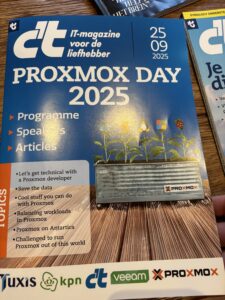
My Perspective as a Speaker
As a speaker, I had the pleasure of being part of an exciting program. At the same time, I was a participant: both at the same time – that’s what makes such days special. I would like to highlight a few presentations:
- Aaron Lauterer (Linux Software Developer at Proxmox Server Solutions) – “Let’s get technical with a Proxmox developer”: A look at upcoming features of Proxmox VE. The upcoming integration of OCI containers (aka Docker) is particularly exciting.
- Rob Turk (Senior Presales Systems Engineer at Veeam) – “Save the data”: Clearly shows that Proxmox has now arrived in the enterprise world.
- Mark Schouten (CTO at Tuxis) – “Cool stuff you can do with Proxmox”: Proxmox Backup Server in interaction with ZFS, how to make the whole thing more performant and what unexpected problems with SCSI and Western Digital have occurred, Mark Schouten told us about it
- Alexander Wirt – “Balancing workloads in Proxmox”: My own contribution with a focus on the project ProxLB of my esteemed colleague Florian Hoberg, which distributes virtual machines evenly across nodes, again shows the advantages and OSS and open interfaces. These make it easy to add missing functionality and thus compete with the industry giants.
- Robbe Van Herck (Support & Maintenance Engineer at International Polar Foundation) – “Proxmox on Antarctica”: Proxmox in extreme use – at the other end of the world and very far from everyday data center life. Robbe was able to show well that Proxmox also works in the most remote corners of the earth, the other challenges are more exciting here – such as hardware that is overwhelmed by the low temperatures.
- Han Wessels (Operations System Engineer at ESA) – “Challenged to run Proxmox out of this world”: Why Proxmox can also be operated on the ISS or in space – technology meets vision. Han vividly described the challenges that arise, such as the vibration during the launch of the carrier rocket or the radiation that significantly shortens the lifespan of storage.
I was able to take away many impulses – both technically and ideally. And I had good conversations that will certainly pay off further.
Networking & Exchange
The informal part was just as valuable as the program: during the breaks, at lunch or at the get-together in the afternoon, we made new contacts, gained interesting insights and met old acquaintances. It is precisely these moments that make a conference come alive.
Outlook
We are already looking forward to next year. When the Tuxis team calls again, we will be happy to be there again. Many thanks again to all those involved, all speakers and all participants – see you again. In between, this December there will be the first Open Source Virtualization Gathering at our company.
Postgres Ibiza 2025 took place on October 15–17, 2025, at the Palacio de Congresos de Ibiza on the beautiful island of Ibiza in the Mediterranean Sea. The conference is organized by the Spanish non‑profit Fundación PostgreSQL and aims to be a “refreshing, open and diverse Postgres conference” in a “truly unique environment.” And sure enough, the event is intentionally remarkable, organizers curate talks on cutting‑edge topics. The conference spans three days: the first two are devoted to scheduled talks, and the last day is an “unconference workshop day,” where participants propose and vote on topics to discuss.
I had the pleasure of representing our company credativ GmbH with talk, “Iceberg Ahead! PostgreSQL Sailing Confidently in Data Lakehouse Waters.” This was the fourth, heavily updated version of my already very successful talk on PostgreSQL and data lakehouses; earlier versions this year appeared at P2D2 2025 in Prague, PGConf.DE 2025 in Berlin, and Swiss PGDay 2025 in Rapperswil‑Jona. This latest version, developed specifically for Postgres Ibiza, dives deep into the Parquet data format, its use in Apache Iceberg tables, and how PostgreSQL can integrate with it using various extensions and tools.
But every single talk at this conference was interesting and high‑quality. I especially enjoyed these:
- Keynote from Catherine Bouxin (Data Bene) — “Reduce energy usage: contributing towards a greener future while directly improving cost and performance.” She highlighted how IT has become a huge consumer of energy, contributing to climate change—and why every optimization matters. It’s a topic not often discussed in the IT world and it drew a lot of attention from the audience.
- Robert Treat — “Vacuuming Large Tables: How Recent Postgres Changes Further Enable Mission Critical Workloads.” He presented a scary real‑life scenario—a vacuum failure turned into a steep learning opportunity—and explained how to avoid transaction wraparound disasters on extremely high‑load systems.
- Mauricio Zambrano — “PostgreSQL at the Square Kilometre Array Observatory.” The SKAO is a massive global radio‑telescope project, gathering extreme amounts of data every second. Managing this unbelievable data flow with PostgreSQL on Kubernetes is truly a cosmic challenge.
- Álvaro Hernández — “Postgres à la carte: dynamic container images with your choice of extensions.” He presented a new approach to dynamic container images that lets users add whatever PostgreSQL extensions they need without maintaining special custom images for every combination.
- Sweta Vooda — “Beyond Storage: Postgres as a Control Plane.” This session reimagined what we can do with Postgres beyond just storing data. She showed patterns and ideas for building extensions that let PostgreSQL orchestrate external compute engines, offloading heavy workloads to specialized systems.
- On the second day, Álvaro Hernández delivered the keynote “Which Postgres are you running?” about why it’s crucial to know the exact build of PostgreSQL you run. He discussed reproducible builds and SBOMs (Software Bill of Materials), and introduced a new idea for a more reliable solution.
- Grant Zhou — “Universal Database Synchronization with Modern Multi‑Connector Architecture.” He introduced the SynchDB extension, which can perform CDC from multiple sources—MySQL, SQL Server, and Oracle—into PostgreSQL.
- Cédric Villemain — “Stats roll, baby, stats roll.” He explained the new PACS framework for advanced PostgreSQL observability.
- And last but not least, Michael Meskes — “From Code to Commerce: Open Source Business Models.” A long‑time open‑source entrepreneur and founder of credativ, he offered thoughtful insights into business models from dual‑licensing to open‑core to newer cloud/SaaS approaches, with pros and cons for each.
- Challenges and solutions for migration from Oracle to PostgreSQL, including performance optimizations and replacement of Oracle‑specific code
- Different database benchmarks and their use cases, pitfalls and relevance for different use cases
- Migration validation methods
- PostgreSQL extensions development – experiences and best practices
- PostgreSQL observability and monitoring tools
- Growing the next generation of PostgreSQL hackers and contributors
Postgres Ibiza was both technically enriching and personally enjoyable. It’s an inspiring place to recharge your enthusiasm for technology in a deeply inspiring environment while listening to and discussing engaging topics. The small, cozy setting allows for deep, meaningful conversations with everyone—and for making new friends. I’m already looking forward to next year’s edition of this amazing conference!
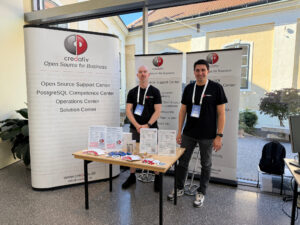
153 participants had the opportunity to attend a total of 21 talks and visit 15 different sponsors, discussing all possible topics related to PostgreSQL and the community.
Also present this time was the Sheldrick Wildlife Trust, which is dedicated to rescuing elephants and rhinos. Attendees could learn about the project, make donations, and participate in a raffle.
The talks ranged from topics such as benchmarking and crash recovery to big data.
Our colleague was also represented with his talk “Postgres with many data: To MAXINT and beyond“.
As a special highlight, at the end of the day, before the networking event, and in addition to the almost obligatory lightning talks, there was a “Celebrity DB Deathmatch” where various community representatives came together for a very entertaining stage performance to find the best database in different disciplines. To everyone’s (admittedly not great) surprise, PostgreSQL was indeed able to excel in every category.
Additionally, our presence with our own booth gave us the opportunity to have many very interesting conversations and discussions with various community members, as well as sponsors and visitors in general.
For the first time, the new managing director of credativ GmbH was also on site after our re-independence and saw things for himself.
All in all, it was a (still) somewhat smaller, but nonetheless, as always, a very instructive and familiar event, and we are already looking forward to the next one and thank the organizers and the entire team on site and behind the scenes.
Dear Open Source Community, dear partners and customers,
We are pleased to announce that credativ GmbH is once again a member of the Open Source Business Alliance (OSBA) in Germany. This return is very important to us and continues a long-standing tradition, because even before the acquisition by NetApp, credativ® was an active and committed member of the Alliance. We look forward with great pleasure to this renewed collaboration and the opportunity to actively contribute to shaping the open-source landscape in Germany once again.
The OSBA
OSBA aims to strengthen the use of Open Source Software (OSS) in businesses and public administration. We share this goal with deep conviction. Our renewed membership is intended not only to promote networking within the community but, above all, to support the important work of the OSBA in intensifying the public dialogue about the benefits of Open Source.
With our membership, we reaffirm our commitment to an open, collaborative, and sovereign digital future. We look forward to further advancing the benefits of Open Source together with the OSBA and all members.
Schleswig-Holstein’s Approach
We see open-source solutions not just as a cost-efficient alternative, but primarily as a path to greater digital sovereignty. The state of Schleswig-Holstein is a shining example here: It demonstrates how public authorities can initiate change and reduce dependence on commercial software. This not only leads to savings but also to independence from the business models and political influences of foreign providers.
Open Source Competition
Another highlight in the open-source scene is this year’s OSBA Open Source Competition. We are particularly pleased that this significant competition is being held this year under the patronage of Federal Digital Minister Dr. Karsten Wildberger. This underscores the growing importance of Open Source at the political level. The accompanying sponsor is the Center for Digital Sovereignty (ZenDiS), which also emphasizes the relevance of the topic.
We are convinced that the competition will make an important contribution to promoting innovative open-source projects and look forward to the impulses it will generate.
Further information about the competition can be found here:
Key Takeaways
- credativ GmbH has rejoined the Open Source Business Alliance (OSBA) in Germany.
- The OSBA promotes the use of open-source software in businesses and public administration.
- Membership reaffirms the commitment to an open digital future and fosters dialogue about Open Source.
- Schleswig-Holstein demonstrates how open-source solutions can enhance digital sovereignty.
- The OSBA’s Open Source Competition is under the patronage of Federal Minister for Digital Affairs Dr. Karsten Wildberger.
Initial situation
Some time ago, Bitnami announced that it would be switching its public container repositories.
Bitnami is known for providing both Helm charts and container images for a wide range of applications. These include Helm Charts and container images for Keycloak, the RabbitMQ cluster operator, and many more. Many of these charts and images are used by companies, private individuals, and open source projects.
Currently, the images provided by Bitnami are based on Debian. In the future, the images will be based on specially hardened distroless images.
A timeline of the changes, including FAQs, can be found on GitHub.
What exactly is changing?
According to Bitnami, the current Dockerhub Repo Bitnami will be converted on August 28, 2025. All images available up to that point will only be available within the Bitnami Legacy Repositories from that date onwards.
Some of the new secure images are already available at bitnamisecure. However, without a subscription, only a very small subset of images will be provided. Currently, there are 343 different repositories under bitnami – but only 44 under bitnamisecure (as of 2025-08-19). In addition, the new Secure Images are only available in the free version under their digests. The only tag available, “latest,” always points to the most recently provided image. The version behind it is not immediately apparent.
Action Required?
If you use Helm charts from Bitnami with container images from the current repository, action is required. Currently used Bitnami Helm charts mostly reference the (still) current repository.
Depending on your environment, the effects of the change may not be noticeable until a later date. For example, when restarting a container or pod, if the cached version of the image has been cleaned up or the pod was started on a node that does not have direct access (cache) to the image. If a container proxy is used to obtain the images, this may happen even later.
Required adjustments
If you want to ensure that the images currently in use can continue to be obtained, you should switch to the Bitnami Legacy Repository. This is already possible.
Affected Helm charts can be patched with adjusted values files, for example.
Unfortunately, the adjustments mentioned above are only a quick fix. If you want to use secure and updated images in the long term, you will have to make the switch.
This may mean switching to an alternative Helm chart or container image, accepting the new conditions of the bitnamisecure repository, or paying for the convenience you have enjoyed so far.
What are the alternatives?
For companies that are not prepared to pay the new license fees, there are various alternatives:
- Build your own container images: Companies can create their own container images based on Dockerfiles and official base images.
- Open source alternatives: There are numerous open source projects that offer similar functionality to Bitnami. Examples include “Helm Hub” and “Artifact Hub”.
- Community charts: Many projects offer their own Helm charts, which are maintained by the community.
References
- https://news.broadcom.com/app-dev/broadcom-introduces-bitnami-secure-images-for-production-ready-containerized-applications
- https://github.com/bitnami/charts/issues/35164
This weekend, it was time once again for FrOScon 2025. With perfect summer weather – not too hot, not too cold – the event took place at the university in Sankt Augustin, as it does every year. But this year was different: FrOScon celebrated its 20th anniversary. I have a special connection to the conference. Not only is it the largest local open source conference, but I have also been a part of it for many years. I have given countless presentations, organised Debian stands, and run and organised developer tracks. In 2007, I even had the pleasure of being part of the organising team. In a way, FrOScon is like coming home. Everywhere you look, you see familiar faces you've known for many years, former and current colleagues, good friends from the open source scene. The only comparable event is Fosdem in Brussels – which is not surprising, as Fosdem is the great role model for FrOScon.
A journey through time – 20 years of FrOScon
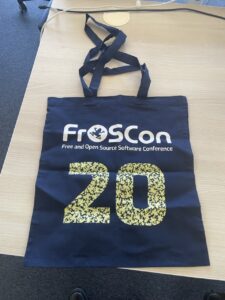
I was already involved in the first FrOScon as an exhibitor for the Debian project, speaker and organiser of the Debian track (together with my colleague Martin Zobel-Helas, who is still involved). I could probably still give the presentation on techniques for combating spam today without changing a word, as the topic has lost none of its relevance. The first FrOScon closed its doors with a very respectable attendance of around 300 visitors. I was so enthusiastic that I got directly involved in the organisation the following year – this was also the year we introduced the famous bouncy castle ;). Over the course of 20 years, FrOScon has developed into one of the largest German OSS community events and now attracts around 1,500 visitors every year. Over the years, the conference has also attracted various prominent keynote speakers, including Andrew Tanenbaum and Richard Stallman, to name but a few. Then as now, I can say that FrOScon is the best conference in the West.
FrOScon 2025
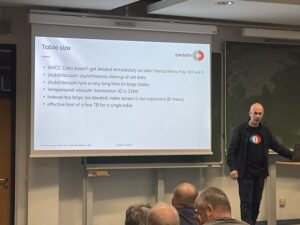
Let's get to the actual content of this blog post – FrOScon 2025. We were represented this year with two presentations and several colleagues as visitors. My colleague Patrick Lauer dedicated one of the rooms to the topic of "Postgres with many data". Thanks to c3voc, the presentation is also available as a stream for anyone who was unable to attend, so everyone can fill this knowledge gap at a later date.
I also gave a presentation again this year. The topic was Proxmox VE and external block devices. I talked about the different types of block devices, such as ISCSI, Fibre Channel and NVMEoF, and how to use them. This presentation is also available in the c3voc video archive.
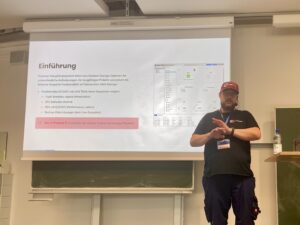
Conclusion
This FrOScon was once again a successful event for community members and interested professionals. It's a bit like a class reunion: you see lots of familiar faces and are excited to find out what everyone has been up to since you last met. Even if I'm hopefully retired by then, I would be delighted to give a presentation at FrOScon #40 ;).
From July 14 to 19, 2025, this year’s Debian Conference (DebConf25) is taking place in Brest, Western France, with over 450 participants – the central meeting of the global Debian community. The DebConf annually brings together developers, maintainers, contributors, and enthusiasts to collaboratively work on the free Linux distribution Debian and exchange ideas on current developments.
credativ is once again participating as a sponsor this year – and is also represented on-site by several employees.
A Week Dedicated to Free Software
DebConf25 offers a diverse program with over 130 sessions: technical presentations, discussion panels, workshops, and BoF sessions (“Birds of a Feather”) on a wide variety of topics from the Debian ecosystem. Some key topics this year:
- Progress surrounding Debian 13 “Trixie”, whose release is currently being actively worked on
- Reproducible Builds, System Integration, and Security Topics
- Debian in Cloud Environments and Container Contexts
- Improved CI/CD Infrastructure and New Tools for Maintainers
Many of the presentations will, as always, be recorded and are publicly available on video.debian.net, or can be viewed live via https://debconf25.debconf.org/.
Credativ’s Commitment – not just On-Site
As a long-standing part of the Debian community, it is natural for credativ to contribute as a sponsor to DebConf again in 2025. Furthermore, our colleagues Bastian, Martin, and Noël are on-site to exchange ideas with other developers, attend presentations or BoFs, and experience current trends in the community.
Especially for companies focused on professional open-source services, Debian remains a cornerstone – whether in data centers, in the embedded sector, or in complex infrastructure projects.
Debian Remains Relevant – both Technically and Culturally
Debian is not only one of the most stable and reliable Linux distributions but also represents a special form of community and collaboration. The open, transparent, and decentralized organization of the project remains exemplary to this day.
For us at credativ, the Debian project has always been a central element of our work – and at the same time, a community to which we actively contribute through technical contributions, package maintenance, and long-term commitment.
Thank You, DebConf Team!
Heartfelt thanks go to the DebConf25 organizing team, as well as to all helpers who made this great conference possible. Brest is a beautiful and fitting venue with fresh Atlantic air, a relaxed atmosphere, and ample space for exchange and collaboration.
Outlook for 2026
Planning for DebConf26 is already underway. We look forward to the next edition of DebConf, which will take place in Santa Fe, Argentina – and to continuing to be part of this vibrant and important community in the future.
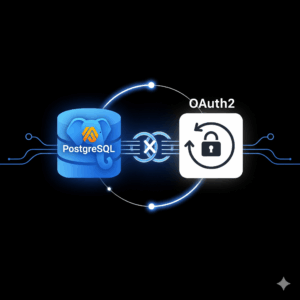
I created a new project directory and started experimenting.
Environment and Objective
The goal was to set up PostgreSQL 18 Beta with OAuth2 authentication, and for the identity provider, I chose Keycloak.
I decided to use Docker Compose to quickly and easily spin up both services.
Docker Compose Configuration
Here is the docker-compose.yml, that I used:
services:
mock-oauth2:
image: quay.io/keycloak/keycloak:24.0
command: start --https-port=8080 --https-key-store-file=/etc/x509/https/localhost.p12 --https-key-store-password=changeit --import-realm --hostname-strict=false --hostname-url=https://mock-oauth2:8080
ports:
- "8080:8080"
environment:
KEYCLOAK_ADMIN: admin
KEYCLOAK_ADMIN_PASSWORD: admin
volumes:
- ./certs:/etc/x509/https
- ./keycloak-realm.json:/opt/keycloak/data/import/realm.json
networks:
- pgnet
postgres18:
build: .
ports:
- "5432:5432"
environment:
POSTGRES_PASSWORD: postgres
volumes:
- ./postgres/postgresql.conf:/etc/postgresql/postgresql.conf
- ./postgres/pg_hba.conf:/etc/postgresql/pg_hba.conf
command: ["-c", "config_file=/etc/postgresql/postgresql.conf"]
networks:
- pgnet
networks:
pgnet:
driver: bridgePostgreSQL expects a connection to the OAuth2 issuer over HTTPS. The same URL must also be reachable from the host, for example, when using the Keycloak UI.
This means: The certificate must be valid and trusted on both the host and in the container.
The hostname used (e.g., https://mock-oauth2:8080) must be correctly resolvable in both environments.
For this, I added the following line to my /etc/hostsfile on the host:
127.0.0.1 mock-oauth2This allowed both the PostgreSQL container and my host to reach the Keycloak service at https://mock-oauth2:8080 reach.
TLS Certificate for Keycloak
Keycloak absolutely requires an HTTPS endpoint for the OAuth2 issuer URL to be accepted by PostgreSQL.
For this, I created a self-signed certificate and converted it into a .p12-keystore package that Keycloak can use.
The .p12certificate is mounted into the container via the following mount:
volumes:
- ./certs:/etc/x509/httpsIn the certsdirectory, the file localhost.p12, which I created from my self-signed key and certificate as follows:
openssl req -x509 -nodes -days 365 \
-newkey rsa:2048 \
-keyout server.key \
-out server.crt \
-subj "/CN=mock-oauth2" \
-addext "subjectAltName = DNS:mock-oauth2,DNS:localhost,IP:127.0.0.1"Keycloak Realm Configuration
I created a minimalist realm file for Keycloak. It contains a client named postgres and a user with corresponding credentials.
Content of keycloak-realm.json:
{
"realm": "pg",
"enabled": true,
"clients": [
{
"clientId": "postgres",
"enabled": true,
"publicClient": false,
"redirectUris": ["*"],
"protocol": "openid-connect",
"secret": "postgres",
"directAccessGrantsEnabled": true,
"standardFlowEnabled": true
}
],
"users": [
{
"username": "postgres",
"enabled": true,
"credentials": [
{
"type": "password",
"value": "postgres"
}
]
}
]
}After importing the realm, Keycloak was ready and the default scope was visible in the UI.
Installation of libpq-oauth and oauth_validator
I had to extend the official PostgreSQL image to install additional dependencies such as the extension libpq-oauth as well as the validator oauth_validator to install.
PostgreSQL 18 experimentally supports OAuth2 authentication. However, PostgreSQL does not include its own validator library. In the official documentation, it states:
The PostgreSQL distribution does not include any libraries for
OAuth2 token validation. Users must provide their own solution
or compile it themselves.
PostgreSQL
Docs –oauth_validator_libraries
For testing, I used the following open-source implementation:
This minimalist C library can be compiled and used as oauth_validator_library in PostgreSQL.
Used Dockerfile
FROM postgres:18beta1
USER root
RUN apt-get update \
&& apt-get install -y libpq-oauth build-essential libkrb5-dev \
libsasl2-dev libcurl4-openssl-dev postgresql-server-dev-18 git \
&& git clone https://github.com/TantorLabs/oauth_validator.git /tmp/oauth_validator \
&& cd /tmp/oauth_validator \
&& make && make install \
&& rm -rf /tmp/oauth_validator \
&& apt-get remove -y build-essential git \
&& apt-get autoremove -y && rm -rf /var/lib/apt/lists/*I then used this image for the `postgres18` service in my Docker Compose setup.
Trusting the Keycloak CA with PostgreSQL
PostgreSQL must trust the certificate presented by Keycloak, otherwise the connection to the OAuth2 issuer will be rejected.
For this, I copied the `mock-oauth.crt` file into the PostgreSQL container and placed it in the typical CA path:
/usr/local/share/ca-certificates/Then, inside the container, I executed the following command:
update-ca-certificatesAfter that, the certificate was accepted and PostgreSQL could successfully verify the connection to the HTTPS issuer.
PostgreSQL Configuration
In pg_hba.conf , I added the following line:
host all all all oauth scope="profile" issuer="https://mock-oauth2:8080/realms/pg" map="oauthmap"In pg_ident.conf, I mapped the identity provided by the token to the PostgreSQL user:
oauthmap "postgresID" "postgres"This mapping may need to be adjusted – depending on how your Keycloak client is configured and which field (e.g.,preferred_username or sub) is passed in the token.
Connection Test with OAuth2
To test the connection, I used the following `psql` command:
psql "host=localhost \
port=5432 \
dbname=postgres \
user=postgres \
oauth_issuer=https://mock-oauth2:8080/realms/pg \
oauth_client_id=postgres \
oauth_client_secret=changeme \
oauth_scope=profile"After the call, a device code message appears, such as:
Visit `https://mock-oauth2:8080/realms/pg/device` and enter
the code FBAD-XXYZ.
After logging in with the user credentials, `psql` successfully establishes a connection to PostgreSQL via OAuth2.
Insights and Tips
- PostgreSQL 18 requires HTTPS for the OAuth2 issuer URL – even in a local setup.
pg_hba.confis sensitive to formatting errors. I had to reload the configuration multiple times (SELECT pg_reload_conf();) and carefullyanalyze the logs.- To trust a local certificate authority, it is sufficient to copy the
.crtcertificate into the container and register it withupdate-ca-certificates. - Keycloak is well-suited for testing with OAuth2, but you may need to experiment with scopes, claims, and secrets until everything aligns with PostgreSQL.
Conclusion
This was an exciting, practical experiment with a promising new feature in PostgreSQL. OAuth2 integration brings PostgreSQL closer to modern identity management solutions and simplifies operation in environments with centralized authentication.
We are very pleased to be hosting the 5th PostgreSQL User Group NRW Meetup – in our new offices right next to Borussia Park in Mönchengladbach! (more…)
Introduction
If you regularly deal with code that needs extensive internationalization capabilities, chances are, that you’ve used functionality from one of the ICU libraries before. Being developed by the Unicode Consortium, ICU provides reliable, mature and extensive implementations for all kinds of tools for internationalization and Unicode text operations. Traditionally, there have been two implementations of ICU, ICU4C implemented in C and ICU4J implemented in Java. These libraries have been the gold standard in correct Unicode text handling and i18n for many years. But for some years now, the Unicode Consortium has been developing on ICU4X, a relatively new implementation in Rust.
The focus of ICU4X is on availability on many platforms and in many programming languages. While older implementations like ICU4C and ICU4J are very mature and at the moment provide more functionality than ICU4X, these libraries have a very large code size and large runtime memory footprint, making them infeasible to use in resource constrained environments like in web browsers or on mobile or embedded devices. ICU4X takes care to reduce library code size and provides additional facilities to optimize the code size of both the library itself and the Unicode data shipped with an application.
In this article, I will provide an overview of what ICU4X can do and how to do it. If you’ve worked with other ICU implementations before, many of them will probably feel familiar, if, on the other hand, you never came in contact with ICU, this article should give you a good introduction on how to perform various Unicode text operations using ICU4X.
Prerequisites
I will be showing a lot of code examples on how to use ICU4X in Rust. While it should not be strictly necessary to understand Rust to understand the basics of what’s going on, some familiarity with the language will definitely help to understand the finer details. If you’re unfamiliar with Rust and want to learn more, I recommend The Rust Book as an introduction.
During the examples I’ll be referring to various functions and types from ICU4X without showing their types in full detail. Feel free to open API documentation alongside this article, to look up any types for the functions mentioned.
Test setup
If you want to run the example for yourself, I recommend setting up a cargo project with the appropriate dependency:
$ cargo new --bin icu4x-blog $ cd icu4x-blog $ cargo add icu
This initializes a basic Cargo.toml and src/main.rs. Now you can paste any example code into the generated main functions inside main.rs and run your examples using cargo run:
$ cargo run
Finished `dev` profile [unoptimized + debuginfo] target(s) in 0.02s
Running `target/debug/icu4x-blog`
Hello, world!
For now this only outputs the default “Hello, world!“ message generated by cargo. So let’s go on to add our own examples.
Locales
The behavior of some of ICU4X’s operations depends on lingual or cultural context. When they do, we need to specify what lingual or cultural background we want. We do this in the form of so-called Locales. At its core, a locale is identified by a short string identifying a language and region. They usually look something like “en-US” for an American English locale, or “de-AT” for German language locale as spoken in Austria.
Locales don’t do anything exciting on their own. They only tell other operations how to behave, so construction is basically the only thing we do with Locales. There are two main ways to construct a locale. We can use the locale! macro to construct and validate a static Locale like this:
let en_us = icu::locid::locale!("en-US");
println!("{en_us}");Or we can try to parse a locale from a string at runtime:
let de_at = "de-AT".parse::<icu::locid::Locale>().unwrap();
println!("{de_at}");Note that parsing a locale can fail on invalid inputs. This is encoded by the parse function returning a Result<Locale, ParserError>. In the example above we use unwrap to ignore the possibility of an error, which will panic on actual invalid inputs:
let invalid_locale = "Invalid!".parse::<icu::locid::Locale>().unwrap();
println!("{invalid_locale}");Taken together, these examples will produce the following output:
$ cargo run [...] en-US de-AT thread 'main' panicked at src/main.rs:8:67: called `Result::unwrap()` on an `Err` value: InvalidLanguage note: run with `RUST_BACKTRACE=1` environment variable to display a backtrace
In practical scenarios, you will probably want to detect locales dynamically at runtime via some standard mechanism provided by your operating system or some other execution platform. Unfortunately, there is currently no standardized way to detect ICU4X locales from external sources, but progress to implementing such a solution is tracked in this issue.
Now that we’ve looked on how to construct Locales, let’s look at some operations that need locales to function.
Collation
The first operation we’re going to look at is collation. You’re probably familiar with the concept of comparing strings lexicographically. In Rust the str type already implements the Ord trait, allowing us easy lexicographic comparisons and sorting of strings. However not all languages and cultures agree on which order letters should be sorted in. As an example, in Germany the letter Ä is usually sorted right after A, while in Sweden the letter Ä is usually sorted after Z. Rust’s standard method of comparing strings does not take these regional differences into account. ICU4X provides us with collation functionality to compare and sort strings with these cultural differences in mind.
Construction
The first step for doing so is to create a Collator like this:
let de_de = icu::locid::locale!("de-DE");
let collator_de = icu::collator::Collator::try_new(&de_de.into(), Default::default()).unwrap();The first parameter is the locale we want collation for. Or technically, it’s a DataLocale, because that’s what try_new wants. The difference doesn’t need to concern us too much right now. Just know, that we can convert a Locale to a DataLocale using .into(). The second parameter is a CollatorOptions structure, which we could use to specify more specific options for the collation. We won’t look at the specific options here and instead just use the default options, but check out the API documentation if you’re curious about what options you can specify. At last, we unwrap the Collator, since creating it can fail in cases where no collation data for the given locale could be found. We’ll talk about this possibility later when talking about data handling.
Now that we have one collator for the de-DE locale, let’s build another for Swedish (sv-SE):
let sv_se = icu::locid::locale!("sv-SE");
let collator_sv = icu::collator::Collator::try_new(&sv_se.into(), Default::default()).unwrap();Usage
Now that we have built some collators, let’s sort some strings with the standard Rust comparison and different locales to see the different results:
let mut strings = ["Abc", "Äbc", "ZYX"];
strings.sort_by(Ord::cmp);
println!("Rust default sorted: {strings:?}");
strings.sort_by(|a, b| collator_de.compare(a, b));
println!("Collated de-DE: {strings:?}");
strings.sort_by(|a, b| collator_sv.compare(a, b));
println!("Collated sv-SE: {strings:?}");This produces the following output:
$ cargo run [...] Rust default sorted: ["Abc", "ZYX", "Äbc"] Collated de-DE: ["Abc", "Äbc", "ZYX"] Collated sv-SE: ["Abc", "ZYX", "Äbc"]
As predicted, the German collation sorted the strings differently than the Swedish collation. Incidentally, the default Rust order sorted these specific strings the same as the Swedish collation, though in practice you shouldn’t rely on coincidences like this and always use the correct collation when sorting Strings for display purposes.
Calendars
Sometimes it’s easy to forget, but not all cultures use the same calendar system. And even different cultures sharing the same calendar system might use different formats to represent dates. ICU4X provides support for converting between representations of different calendars and formatting them according to local taste. Besides the Gregorian calendar, popular in most regions of the world, and the ISO calendar often used for technical purposes, many other calendars, such as Japanese, Ethiopian or Indian are supported. However, no functionality for retrieving the current time is currently provided, so in real applications you will have to convert from some other representation first.
Construction
In the next example, we have a known date given as an ISO date, that we want to display in some locale:
let iso_date = icu::calendar::Date::try_new_iso_date(1978, 3, 8).unwrap();
Next we create a DateFormatter:
let local_formatter = icu::datetime::DateFormatter::try_new_with_length(
&icu::locid::locale!("th").into(),
icu::datetime::options::length::Date::Medium,
)
.unwrap();We will use the formatter to format dates into locale specific textual representation. During creation we get to pick a locale (or rather a DataLocale again). We’re picking the Thai locale, because unlike most of the world it uses the Buddhist calendar instead of the Gregorian calendar. We also get to pick a format length that gives us some control over the length of the date format. We use the medium length, which uses abbreviated month names, if these are available in the locale, or numeric months otherwise.
Formatting
Now we just format the date and print it:
let local_format = local_formatter.format(&iso_date.to_any()).unwrap();
println!("{local_format}");Which gives us this output:
$ cargo run [...] 8 มี.ค. 2521
If, like me, you’re not well versed in the Buddhist calendar and Thai month names, this probably won’t tell you much. But that’s exactly the point of using an i18n library like ICU4X. We can use general operations that do the correct thing for any supported locale, without having to understand the intricacies of every specific locale.
When calling format you have to be careful to pass a date that belongs to a calendar suitable for the locale of the formatter. Even though its parameter type suggests that a date from any calendar can be used, the operation only accepts dates from the ISO calendar or dates from correct calendar for that locale (i.e. in this example we could have also passed a date that was already formatted according to the Buddhist calendar). In this case, we used a ISO date, which is always accepted. If you have a date in an entirely different calendar it gets more complicated. You would need to convert your date to the correct target calendar explicitly and then pass it to format. For this you obtain the needed calendar using AnyCalendar::new_for_locale and do the conversion using Date::to_calendar.
Normalization
Unicode texts are represented as a sequence of numbers called code points. But not each code point has its own atomic meaning. Some sequences of code points combine into groups to represent more complex characters. Due to this complexity it is possible in many cases, that different sequences of code points represent the same sequence of semantic characters. As an example, the letter Ä can be represented as the single code point U+00C4 or as the sequence of code points U+0041 U+0308 (an A followed by combining two dots above). This has implications when we want to compare strings for equality. Naively we might want to compare strings by checking if each of the code points are equal. But that would mean that strings that compare different, because they contain different code points, actually contain the semantically same characters.
To deal with this situation, ICU4X gives us string normalization. The idea is as follows: Before comparing strings to each other we “normalize” each string. Normalization transforms the string into a normalized representation, thereby ensuring that all strings that are semantically equal also have the same normalized representation. This means that once we have normalized the strings we want to compare, we can simply compare the resulting strings by code point to determine if the original strings where semantically the same.
Normalization forms
Before we can perform this normalization, we need to understand that there are multiple forms of normalization. These forms are differentiated by two properties. On one axis, they can be composing or decomposing. On the other axis, they can be canonical or compatible.
Composed normalization forms ensure that the normalized form has as few code points as possible, e.g. for the letter Ä the single code point form would be used. Decomposed normalization on the other hand always chooses the representation requiring the most code points available, e.g. for the letter Ä the two code point form would be used. With composed normalization we need less storage space to store the normalized form. However, composed normalization is also usually slower to perform than decomposed normalization, because internally composed normalization first has to run decomposed normalization and then compress the result. As a rule of thumb, it is usually recommended that composed normalization be used when the normalized strings are stored on disk or sent over the network, whereas decomposed normalization should be used when the normalized form is only used internally within an application.
Canonical normalization only considers different code point representations of the same characters to be equal. Compatible normalization goes a step further and considers characters that convey the same meaning, but differ in representation, to be equal. As an example, under compatible normalization the characters “2”, “²” and “②” are all considered equal, whereas under canonical normalization they are different. Compatible normalization can be appropriate when normalizing identifiers such as usernames to detect close-but-different lookalikes.
Taking all of this together, this gives us four different possible forms of normalization:
- NFC: Composing and Canonical
- NFKC: Composing and Compatible
- NFD: Decomposing and Canonical
- NFKD: Decomposing and Compatible
Performing normalization
Once we have decided on a normalization form to use, actually performing the normalization is easy. Here’s an example using NFD normalization:
let string1 = "\u{00C4}";
let string2 = "\u{0041}\u{0308}";
let rust_equal = string1 == string2;
let normalizer = icu::normalizer::DecomposingNormalizer::new_nfd();
let normalized1 = normalizer.normalize(string1);
let normalized2 = normalizer.normalize(string2);
let normalized_equal = normalized1 == normalized2;
println!(
"1: {string1}, 2: {string2}, rust equal: {rust_equal}, normalized equal: {normalized_equal}"
)$ cargo run [...] 1: Ä, 2: Ä, rust equal: false, normalized equal: true
As we can see, string1 and string2 look the same when printed, but the == operator doesn’t consider them equal. However, normalizing both strings and comparing the results, does compare them equal.
NFKD normalization can be used by constructing the normalizer using DecomposingNormalizer::new_nfkd. NFC and NFKC are accessible using ComposingNormalizer::new_nfc and ComposingNormalizer::new_nfkc respectively.
Segmentation
When we look into Unicode texts, we’ll often find that they aren’t only made up of individual code points, but rather of larger constructs consisting of multiple code points, such as words or lines. When processing text, it is often necessary to recognize, where boundaries between these individual pieces are. In ICU4X this process is called segmentation and it provides us with four different types of segments to recognize: graphemes, words, sentences, and lines. The process of segmenting is very similar for each one, but each of them also has their own quirks, so we’ll look at each of them in turn.
Graphemes
As previously mentioned, some code points combine with other code points thereby gaining a different meaning than each code point would have individually. If we break strings apart between two combined code points, the code points can no longer combine and thus revert to their individual meaning. Here’s an example of such unintentional changes in meaning happening:
let string1 = "\u{61}\u{308}\u{6f}\u{308}\u{75}\u{308}";
let string2 = "stu";
println!("string1: {string1}, string2: {string2}");
let (split1, split2) = string1.split_at(4);
println!("split1: {split1}, split2: {split2}");
println!("combined: {string2}{split2}");
$ cargo run [...] string1: äöü, string2: stu split1: äo, split2: ̈ü combined: stüü
First, note that the output of split1 and split2 shows that what was previously an ö has now been split into an o and a loose pair of two dots. Even worse: when we combine string2 and split2 in a single output, the dots at the start of split2 combine with the last character of string2 forming an extra “ü” that was never intended to exist.
Graphemes to the rescue
So how do we know where it is safe to split a string, without altering the meaning of its contained characters? For this purpose, Unicode defines the concept of grapheme clusters, which is a sequence of code points that have a single meaning together, but are unaffected by the meaning of code points around them. As long as we’re careful to split strings only on the boundaries between grapheme clusters, we can be sure not to inadvertently change the semantics of characters contained in the string. Similarly, when we build a user interface for text editing or text selection, we should be careful to present a single grapheme cluster to the user as a single unbreakable unit.
To find out, where the boundaries between grapheme cluster are, ICU4X gives us the GraphemeClusterSegmenter. Let’s look at how it would have segmented our string from earlier:
let string = "\u{61}\u{308}\u{6f}\u{308}\u{75}\u{308}";
println!("string: {string}");
let grapheme_boundaries: Vec<usize> = icu::segmenter::GraphemeClusterSegmenter::new()
.segment_str(string)
.collect();
println!("grapheme boundaries: {grapheme_boundaries:?}");$ cargo run [...] string: äöü grapheme boundaries: [0, 3, 6, 9]
As we can see, the segment_str function returns an iterator over indices where boundaries between grapheme clusters are located. Naturally the first index is always 0 and the last index is always the end of the string. We can also see, that the index 4, where we split our string in the last example, was not a boundary between grapheme clusters, and thus our split caused the change in meaning we observed. Had we instead split the string at the indices 3 or 6, we would have not had the same problems.
Words
Sometimes it is helpful to separate a string into its individual words. For this purpose, we get the aptly named WordSegmenter. So let’s get right into it:
let string = "Hello world";
println!("string: {string}");
let word_boundaries: Vec<usize> = icu::segmenter::WordSegmenter::new_auto()
.segment_str(string)
.collect();
println!("word boundaries: {word_boundaries:?}");$ cargo run [...] string: Hello world word boundaries: [0, 5, 6, 11]
So far this is very similar to the GraphemeClusterSegmenter we’ve seen before. But what if we want the words themselves and not only their boundaries? We can just iterate over windows of two boundaries at a time and slice the original string:
let words: Vec<&str> = word_boundaries
.windows(2)
.map(|bounds| &string[bounds[0]..bounds[1]])
.collect();
println!("words: {words:?}");
$ cargo run [...] words: ["Hello", " ", "world"]
This looks better. It gives use the two words we expect. It also gives us the white space between words. If we do not want that, we can ask the WordSegmenter to tell us if a given boundary comes after a real word or just some white space and filter on that:
let word_boundaries: Vec<(usize, icu::segmenter::WordType)> =
icu::segmenter::WordSegmenter::new_auto()
.segment_str(string)
.iter_with_word_type()
.collect();
println!("word boundaries: {word_boundaries:?}");
let words: Vec<&str> = word_boundaries
.windows(2)
.filter_map(|bounds| {
let (start, _) = bounds[0];
let (end, word_type) = bounds[1];
if word_type.is_word_like() {
Some(&string[start..end])
} else {
None
}
})
.collect();
println!("words: {words:?}");
$ cargo run [...] word boundaries: [(0, None), (5, Letter), (6, None), (11, Letter)] words: ["Hello", "world"]
In case you were wondering why the constructor for WordSegmenter is called new_auto, it’s because there are multiple algorithms for word segmentation to choose from. There are also new_dictionary and new_lstm and not every algorithm works equally well for different writing systems. new_auto is a good choice in the general case, as it automatically picks a good implementation based on the actual data encountered in the string.
Sentences
If we want to break strings into sentences, SentenceSegmenter does just that. There’s not much special to it, so let’s get right into it:
let string = "here is a sentence. This is another sentence.";
println!("string: {string}");
let sentence_boundaries: Vec<usize> = icu::segmenter::SentenceSegmenter::new()
.segment_str(string)
.collect();
println!("sentence boundaries: {sentence_boundaries:?}");
let words: Vec<&str> = sentence_boundaries
.windows(2)
.map(|bounds| &string[bounds[0]..bounds[1]])
.collect();
println!("words: {words:?}");$cargo run [...] string: here is a sentence. This is another sentence. sentence boundaries: [0, 20, 45] words: ["here is a sentence. ", "This is another sentence."]
No surprises there, so let’s move on.
Lines
The LineSegmenter identifies boundaries at which strings may be split into multiple lines. Let’s see an example:
let string = "The first line.\nThe\u{a0}second line.";
println!("string: {string}");
let line_boundaries: Vec<usize> = icu::segmenter::LineSegmenter::new_auto()
.segment_str(string)
.collect();
println!("line boundaries: {line_boundaries:?}");
let lines: Vec<&str> = line_boundaries
.windows(2)
.map(|bounds| &string[bounds[0]..bounds[1]])
.collect();
println!("lines: {lines:?}");$ cargo run
[...]
string: The first line.
The second line.
line boundaries: [0, 4, 10, 16, 28, 33]
lines: ["The ", "first ", "line.\n", "The\u{a0}second ", "line."]This gives us more individual “lines” than we might have previously anticipated. That’s because the LineSegmenter not only gives us boundaries on line breaks already contained in the string, but also gives us boundaries in places where a soft line break could be placed. This can be very useful if you want to wrap a long string over multiple lines.
If you want to differentiate whether a given boundary is a hard line break contained in the string or just an opportunity for an optional line break, you can negotiate the character right before the line break using icu::properties::maps::line_break.
Case Mapping
When processing Unicode texts, there is sometimes the need to transform letter between lower case and upper case. ICU4X gives us various tool for this, so let’s look at each of them.
UPPERCASE and lowercase
Lowercasing and uppercasing are very simple operations on the surface. They do similar things to Rust’s built-in str::to_lowercase and str::to_uppercase methods. So let’s see why ICU4X has separate support for them:
let string = "AaBbIıİi";
println!("string: {string}");
let locale = icu::locid::locale!("de-DE");
let cm = icu::casemap::CaseMapper::new();
let lower = cm.lowercase_to_string(string, &locale.id);
let upper = cm.uppercase_to_string(string, &locale.id);
println!("lower: {lower}, upper: {upper}");$cargo run [...] string: AaBbIıİi lower: aabbiıi̇i, upper: AABBIIİI
So far this looks like the familiar lowercasing and uppercasing operations from most languages’ standard libraries. But note that we had to provide locale.id to run these operations. The twist here is that the rules for lowercasing and uppercasing can vary by language, which is reflected in ICU4X’s variants of these operations. Observe how the result changes if we use the locale tr-TR instead of de-DE:
$ cargo run [...] string: AaBbIıİi lower: aabbııii, upper: AABBIIİİ
With ICU4X we don’t need to know the details of how different lowercase and uppercase letters pair up in different languages. As long as we pass the correct locale, ICU4X will do the correct thing.
Note however, that uppercasing and lowercasing operations are only intended for display purposes. If you want to compare strings case-insensitively, you want case folding instead, which we will look at later.
Titlecasing
Titlecasing is the process of uppercasing the first letter of a segment and lowercasing all other characters. So for example, if we wanted to titlecase every word in a string, we would first use a WordSegmenter to extract every word and then use a TitlecaseMapper to perform the titlecasing on every word.
let string = "abc DŽ 'twas words and more wORDS";
println!("string: {string}");
let locale = icu::locid::locale!("de-DE");
let cm = icu::casemap::TitlecaseMapper::new();
let word_segments: Vec<usize> = icu::segmenter::WordSegmenter::new_auto()
.segment_str(string)
.collect();
let titlecased: String = word_segments
.windows(2)
.map(|bounds| {
let word = &string[bounds[0]..bounds[1]];
cm.titlecase_segment_to_string(word, &locale.id, Default::default())
})
.collect();
println!("titlecased: {titlecased}");$ cargo run [...] string: abc DŽ 'twas words and more wORDS titlecased: Abc Dž 'Twas Words And More Words
Again we had to provide &locale.id to specify which language-specific rules to obey during case transformations. Additionally we can pass other options as a third parameter. Here we’ve used the default options, but feel free to checkout out the API documentation to see what other options are supported.
Note how DŽ was transformed to Dž, even though it is a single letter whose regular uppercase form is DŽ. This is because each character has separate uppercase and titlecase forms, which just happen to be the same for most latin characters. Also note that 'twas was transformed to 'Twas. This is because the TitlecaseMapper titlecases the first letter in a word and skips over non-letter characters at the start of a word when doing so.
Case folding
Sometimes we want to tell whether two strings are equal while ignoring differences in casing. Traditionally this has been done by transforming both strings to lower case or upper case to eliminate differences in casing and comparing those strings. With Unicode strings, for some characters simple lowercasing or uppercasing isn’t enough to eliminate all differences in casing. As an example, the German letter ß uppercases to SS, but there’s also an uppercase version of ß: ẞ, which uppercases to itself, but lowercases to a regular ß. To consistently eliminate all casing differences, we need to map SS, ß, and ẞ all to the same output character. Luckily for us, ICU4X gives us the case folding operation, which promises to do just that. Let’s see it in action:
let string = "SSßẞ";
println!("string: {string}");
let locale = icu::locid::locale!("de-DE");
let cm = icu::casemap::CaseMapper::new();
let upper = cm.uppercase_to_string(string, &locale.id);
let lower = cm.lowercase_to_string(string, &locale.id);
let folded = cm.fold_string(string);
println!("upper: {upper}, lower: {lower}, folded: {folded}");$ cargo run [...] string: SSßẞ upper: SSSSẞ, lower: ssßß, folded: ssssss
As we see, in the folded string all the different versions of ß have been consistently turned into ss, which successfully eliminates all casing differences. It also means that a single ß would be considered equal to a lowercase ss, which we might not have considered equal otherwise. This is a kind of ambiguity that is hard to avoid when comparing strings case-insensitively.
Note that we didn’t have to specify any locale or language for the case folding operation. This is because case folding is often used for identifiers that are supposed to behave identically regardless of the lingual context they’re used in. The case folding operation tries to use rules that work best across most languages. However, they don’t work perfectly for Turkic languages. To deal with this, there’s an alternative case folding operation fold_turkic_string just for Turkic languages. In most cases you’ll probably want to use the general folding operation, unless you’re really sure you need the special behavior for Turkic languages.
Case-insensitive comparison
Given the case folding operation, we could implement a function to compare two strings case-insensitively like this:
fn equal_ci(a: &str, b: &str) -> bool {
let cm = icu::casemap::CaseMapper::new();
cm.fold_string(a) == cm.fold_string(b)
}
Data handling
So far we’ve looked at various operations that work correctly in a vast number of locales over strings made up of a huge amount of valid code points. On the surface, these operations were relatively easy to use and most of the time we only needed to specify our input and a desired locale to get the correct result. However, in the background ICU4X needs a lot of data about different locales and Unicode characters to do the right thing in every situation. But so far, we never had to be concerned with this data at all.
So where does ICU4X get all this data from? In the default configuration we’ve been using so far, the data is shipped as part of the library and compiled directly into our application executable. This has the benefit that we don’t need to worry about shipping the data along with the binary and getting access to it at runtime, as the data is always included in the binary. But it comes at the cost of sometimes dramatically increased binary sizes. Since data for a large number of locales is included by default, we’re talking about tens of megabytes of data being included in the binary.
Alternatives to embedded data
Since ICU4X is designed to run even in minimalist environments, such as embedded devices, forcing this increased application binary size on every application would be unacceptable. Instead, ICU4X provides multiple ways to access the relevant data. Besides using the included default set of data, you can also generate you own set of data using icu4x-datagen. This allows you to reduce the data included from the beginning, either by limiting the number of locales to include or by limiting the functionalities supported by the data. Furthermore you have the choice between compiling this data directly into your application binary or putting it into separate data files that your application then parses at runtime.
Reducing the set of available runtime data of course comes with the benefit of reducing the data size needed to ship with your application. On the other hand it has the drawback of reducing the set of operations you can successfully run at runtime. Each bit of data you remove, can have the effect of making some operation fail, if no data is available to perform that operation with the requested locale. As with many other things, reducing the data size has obvious benefits, but it is always a tradeoff. In the examples above we usually used unwrap to ignore the possibility of errors, but in a real application you’ll probably want more sophisticated error handling, like falling back to some non-failing behavior or at least reporting the error to the user.
I’ll avoid going through all the available options in detail, and instead refer to ICU4X’s official Tutorial on data management instead. It should explain all the supported ways to make the required data available to your application.
Conclusion
I hope this has given you a satisfactory overview of what ICU4X can do. As we have seen, a lot of functionality works well out of the box. In other areas functionality is still lacking. For example, I’ve mentioned earlier, that there’s currently no comfortable way to detect the user’s preferred locale in a standard way from the execution environment. Another area where ICU4X is currently lacking behind its C and Java counterparts is translation support. ICU4X and ICU4J provide capabilities for formatting localized message using MessageFormats, which ICU4X still lacks. Similarly, ICU4X doesn’t currently seem to have functionality to deal with resource bundles.
Even though ICU4X doesn’t have all the functionality you might expect of it yet, overall it seems like a good choice for those cases, where it already brings all the required functionality. Given some more time, we may even see more and more of the missing functionality to land in ICU4x.




